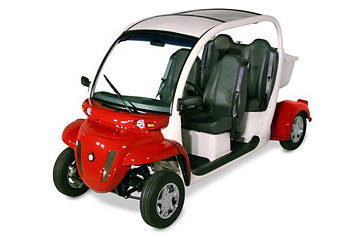
As you might have heard, gas prices are at an all-time high, recently breaking the $4-a-gallon barrier. Here in New York City, where I live, a gallon of regular will set you back $4.31. Though high gas prices have caused Americans to drive less — 11 billion fewer miles this March compared to a year earlier — and have boosted sales of fuel-efficient cars, there's not a whole lot that most of us can do about the problem except complain. A lot. Very loudly.
But what if instead of running your car on gasoline, you could run it on pure electricity? Not only would that help the environment — one-third of U.S. carbon emissions come from cars and trucks — but in an era of ever-increasing gas prices, it would help your wallet as well. Unfortunately, the auto industry has consistently failed to build and sell a truly marketable electric car. They were either too expensive or too weak on the road — or too often both; and back in those halcyon days when our chief climate fear was a new ice age, low gas prices made electric cars unnecessary.
Clearly that has changed, and young companies like GEM are taking advantage. GEM, which stands for Global Electric Motorcars, is a Fargo, North Dakota, subsidiary of Chrysler that's been selling small electric vehicles for a decade — or as GEM President Rick Kapser has said, "back when gas was a $1.25 a gallon." GEMs may look a bit like golf carts — and they may occasionally be used as golf carts as well — but they are real, street-legal vehicles, drivable on any road with a speed limit of 35 mph or less. Their success provides a good window into the growth of the electric car market — unlike Chrysler's other brands, GEM is profitable, selling about 37,000 cars over the past decade, ranging from $7,000 bare-bones 2-seaters to larger, more comfortable vehicles that can cost more than $12,000.
The key with any electric car is the strength of its battery, and GEM has a good one. You can drive for up to 30 miles on a single charge, and repowering the battery takes six to eight hours, using any standard outlet. A GEM won't win a drag race — maximum speed is 25 mph, though with a surprising amount of pep. I took a four-seat GEM for a test ride through New York City's Central Park. Check out my experience here:
GEMs certainly aren't the answer to the nation's need for a decent, inexpensive electric car. First of all, they're not that inexpensive — considering what you get, the GEM's price seems a bit too steep. And while the car might work around a small neighborhood, or a dense city like New York, Americans increasingly commute longer and longer distances — an electric car will only work if it can drive the way a gas-powered vehicle can. No auto company has achieved that yet, but the good news is that after years of ignoring electric car research, almost every major manufacturer has a crash electric program. Two of the most promising come from the two biggest car companies in the world, General Motors and Toyota. Both are working hard on plug-in electric vehicles, cars that could run for maybe 40 to 50 miles on a battery charge — far enough to cover most Americans' daily driving — with a gasoline or biofuel-powered extra engine to cover any additional driving. If it can be made economical, that would be an ideal compromise for the Earth and our budgets. And best of all, we could finally stop talking about the price of gas.
